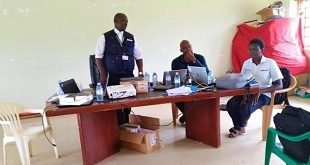
Implementation of the new law is a catalyst for bolstering growth of the sector
Kampala, Uganda | JULIUS BUSINGE | The government expects to increase jobs in the minerals sector by 63% to 2.6million in FY2024/2025 from 1.6million reported in 2017/2018, according to Peter Lokeris, the state minister of minerals at the Ministry of Energy and Mineral Development.
Lokeris, who was speaking at a sensitization workshop on Uganda’s mining and minerals legal framework held in Kampala on Aug.29, said Uganda has good potential for minerals with favourable geological environment for world-class economic mineral deposits.
He said the country’s discoveries of various mineral resources including copper, nickel, gold, chromite, iron ores, tin, tantalite, tungsten, limestone, marble, graphite, gemstones, and rare earth minerals led to an increase in Foreign Direct Investment in the sector from US$ 5 million in 2003 to over US$800 million in 2017.
He said the non-tax revenue from license fees, annual mineral rent, and royalties have significantly increased from approximately Shs1.8 billion in 2003 to Shs11.3 billion in FY 2022/2023.
Uganda Vision 2040 envisions a minerals sector that is a major driver of employment creation and GDP growth.
“Planning and investing in mineral development should be undertaken to realise the sector’s vast potential and returns to the economy,” Lokeris said. “These returns include direct revenue, job creation, and upward and downward linkages to other sectors of the economy including industrialisation, agriculture, and human capital development.”
Over the years, the level of investment in the mineral sector has considerably increased as evidenced by the increase in the number of licenses granted by the government. The mineral licenses have since increased from about 100 mineral licences in 2003 to 556 licences, including 249 exploration licences, eight retention licences, 48 mining Leases, and 76 location licences as of June 2023.
This increase in licenses in the mineral sector is accompanied by a corresponding increase in income and revenue from the sector, Lokeris said.
Key mineral developments
Lokeris said the government expects to begin the implementation of the Mineral Resources Infrastructure Development Project (MRIP) from 2023 to 2028 whose main objective is to establish key infrastructure for monitoring and regulation of exploration and mining activities in the country.
He revealed that the government is also collaborating with Partners such as planetGOLD whose main objective is to reduce the use of mercury in artisanal and small-scale gold mining as well as improve the health and lives of local mining communities.
New gold targets have since been identified in several parts of the country, including Buhweju, Mubende, Namayingo, Karamoja, and Zombo districts.
Over 500 million tonnes of Rare Earth Elements have been estimated in Eastern Uganda by the Makuutu Rare Earth Project. Makuutu is said to have the potential to bolster Uganda’s worldwide positioning among countries with the most significant production of REEs worldwide, after China, sector experts say.
The reserves of high-quality vermiculite at Namekhara in Manafwa District have subsequently increased from 5 million tonnes to the current 54.9 million tonnes.
The government has completed phase one of the airborne geophysical survey, where preliminary data has been acquired over the Karamoja and Lamwo region, completing the 20% gap in the geophysical dataset in the country. Interpretation of the data and sensitisation of communities for ground follow-up is ongoing.
It established the online mining Cadastre and Registry System and Transaction Portal in 2019 to manage mineral rights, including licensing, communication, reporting, and payments.
It is currently upgrading its online mineral licensing system to align with the new law and to ensure transparency.
The ministry launched Artisanal and Small-Scale Miners (ASM) biometric registration in December 2021 to streamline operations and increase revenues.
Other initiatives shall include zoning artisanal mining areas, formalisation, and regularization, training, and provision of extension services to artisanal miners.
On transparency in the sector, Uganda is now a member of the Extractive Industries Transparency Initiative – one avenue through which management of the sector can be managed.
 The Independent Uganda: You get the Truth we Pay the Price
The Independent Uganda: You get the Truth we Pay the Price


